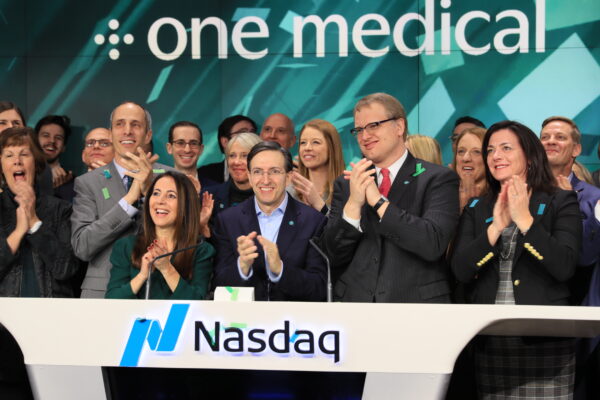
One Medical went public on January 31, with its stock listed on Nasdaq as “ONEM.”
During the height of the Covid-19 pandemic, health systems experienced a great shift, shutting down services for elective procedures and other clinical activities to create capacity for patients affected by the novel coronavirus. They also adopted telemedicine, which had been available for years but suffered from inadequate reimbursement. The forced and accelerated pace of this shift has no precedent in healthcare.
Now, as financially battered health systems begin to emerge to a new normal, investment in the patient experience has never been more important. Every ambulatory visit and every procedure really counts toward attracting and retaining patients. As such, health systems need to force upon themselves a great and purposeful shift towards a better patient experience. They need to disrupt themselves because the American consumer needs and expectations have long been changing and because over the course of a few months with Covid-19, care delivery models accelerated by years.
We’ve chosen to highlight the benchmark healthcare delivery model of the newly public company, One Medical, where positive patient experiences are built into the daily operating culture. Headquartered in San Francisco, the company has a mission to improve the patient experience from beginning to end of the patient care episode. It keeps things simple by committing to the guiding principle of delivering high quality, cost-effective healthcare in a patient-centric process. It confirms our belief that recognition and market share exist for industry leaders who focus their healthcare organizations on delivering great patient experiences.
Compared to the visionaries who designed One Medical, the people who designed large health systems, regardless of how stellar their clinical reputations may be, didn’t design the systems with the goal of delivering great patient experiences. As a result, the crummy state of the patient experience (which begins in a time of need — quelling an ache or treating a serious illness, often a crowded waiting room or even more crowded emergency room — when one feels most vulnerable, spirits are down, and acts of kindness count most) has become an American reality. One can’t necessarily “blame” the designers of large health systems because historically there have been few penalties for delivering an underwhelming patient experience.
With penalties recently instituted, health systems have begun to make attempts to ensure a good patient experience. For instance, hospitals like Massachusetts General Hospital (and most hospitals nationally) have implemented the Center for Medicare Services-required HCAHPS patient satisfaction surveys; their Medicare reimbursement is based in part on the results of the surveys. Some hospitals have created interesting positions such as chief patient experience officers and patient ombudsmen. Leadership knows that at a minimum the creation of new roles begins the process of assigning responsibility and accountability.
Among others, Cleveland Clinic and Mayo Clinic have these positions. Further, some healthcare systems have undertaken empathy training with seriousness of purpose, such as what Long Island’s South Nassau Communities Hospital does. The hospital knows (and it is well accepted) that caretakers are burned out and often need assistance creating cultures and situations that enable them to practice compassion and empathy.
These are fine efforts, but they remind us of the old trope about the manufacturing quality certification, ISO 9001. The saying goes that a company could make cement lifejackets and still be ISO certified. (As long as a company uses a documented quality process and makes lifejackets according to documented procedures, then the cement lifejacket company receives ISO certification.) For health systems, focusing on a satisfying patient experience may ultimately get them the equivalent of a cement life jacket, that is: a satisfying patient experience but that is inadequate.
Care providers need to focus on delighting their customers! That’s wholly different from a satisfying patient experience. In fact, using the word “patient” implies the outdated, patriarchal mode of medicine where the patient is lucky to receive care. The word health systems should use is “customer.” Further, they shouldn’t use the word “satisfaction”—every company serving customers today knows that satisfaction is a low bar. The word health systems should use is “delight.” To be able to delight customers demands a substantially different modus operandi and mindset than satisfying patients. Health systems weren’t and aren’t constructed to delight customers.
So, back to One Medical, which went public on Jan 31. It targeted an IPO open price of $14 and closed at $22 on its first day of trading (it’s currently trading around $35). Why the success? Because it has designed itself to delight customers from the outset. One Medical started with innovative design thinking precepts at the core of what it wanted to do. It combines the design thinking of a place like Apple, and the process thinking of, say, Toyota (i.e., Lean-type philosophies). One Medical seems to know in its bones that it is operating in a bottom-up, competitive system where people have a right to expect extraordinary care and service.
The One Medical model is a form of concierge care for the masses where people pay a $199 annual membership fee. With that, customers gain access to primary care physicians (PCPs) in the cities where it operates (mostly large cities with high density of young working people; San Francisco, Chicago, Washington, DC, etc.). One Medical members can text their physicians, schedule same-day appointments, get video visits, and be treated in attractive, comfortable, uncrowded settings. The One Medical clinicians have, in many cases, opted out of larger systems and into this new model because they want to do less paperwork and provide more care, spending more time with their customers.
Delighting customers in this way is at the vanguard of healthcare. In comparison, large health systems have thrived by leveraging their PCPs as loss leaders. The PCPs are supposed to refer as many patients as possible to specialists, who generate higher, procedure-based income for the system. Considering that One Medical offers no specialist services, its model presumably intends for PCPs to be profit generators. The company will bring positive disruption in healthcare and presents a threat to the loss-leader model that is the playbook for health systems today.
Because it’s investing in change, One Medical is sustaining significant operating losses. But, investors like its long-term prospects, as evidenced by the fact that they’re trading it at $35 per share (up more than 61% between Jan 31 and June 30) and giving it, at $78 million in Q1 revenues (and $276 million in 2019 revenues), a $4.2 billion market cap. Meanwhile, Hospital Corporation of America, the largest for-profit hospital organization in the US, showed a profit for Q1 but has suffered a 25 percent decrease in stock price in that same time period. It had to deal with the great surge presented by the pandemic and, to boot, doesn’t appear to have a long-term plan to deal with the great shift—away from satisfying patients and towards delighting customers.
We expect that as companies like One Medical and its peers gain momentum, it’ll be easier for them to backwards integrate into things like surgeries and acute care than for large healthcare systems to forward integrate into the disruptive innovation of delighting customers. The One Medicals of the world will continue to grow by attracting patients from other providers, gaining power in the market, and referring patients to their choice of specialist care and procedures. The “One Medical” dynamic will fundamentally change how money flows within the system. According to the disruptive innovation playbook, that’s about the time when large health systems will start to see the light and try to adjust their models—possibly too late for improving and saving lives, as they were established to do.
Photo: One Medical
Editor’s Note: Neither Joe Mandato nor Ryan Van Wert owns any One Medical Shares nor do they have any financial relationship with the company. This article should not be viewed as investment advice.










